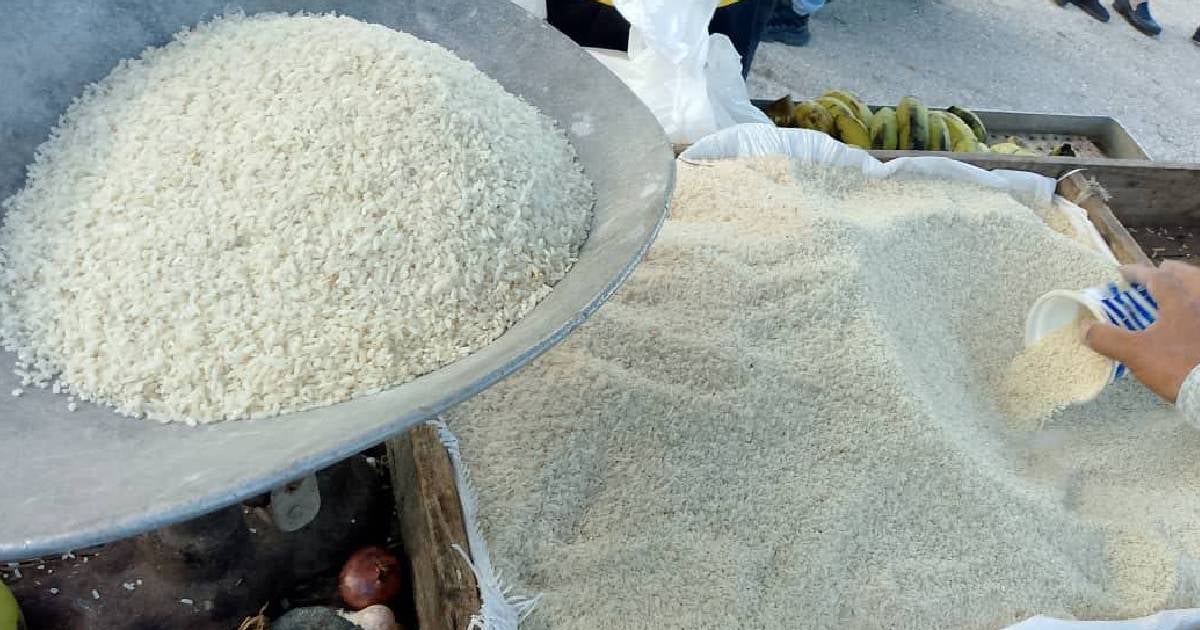
Related videos:
The food crisis in Cuba is worsening with the relentless rise in prices of basic goods in the black market.
In recent days, the price of a pound of rice has reached 300 Cuban pesos (CUP), a figure that highlights the profound scarcity and the deterioration of the population's purchasing power.
According to reports from citizens in several provinces, obtaining rice through the ration book has become an almost impossible task, forcing families to turn to the informal market, where prices have reached exorbitant levels.
In Santa Clara, residents have publicly reported that in the Mipymes near the Fe del Valle Secondary School on the Doble Vía, the price of rice is displayed on boards at 300 CUP per pound, despite the fact that the authorities have tried to regulate it at 170 CUP.
"You cannot be less corrupt and do something for the people", expressed a resident on social media, accusing local authorities of collusion with merchants.
"Before we could find it for 200 or 250 pesos, but now it's a luxury. If you don't have money, you don't eat.", commented a resident of Havana, who wished to remain anonymous.
In several areas of the capital, imported rice from Brazil, Uruguay, and India has exceeded 350 CUP per pound, creating greater uncertainty among the population.
Municipalities like Quivicán, in the province of Mayabeque, have the price set at 300 CUP and it is not exclusive to the black market.
The shortage of rice in state markets is due, in part, to the decline in imports and distribution problems within the country. Cuba relies heavily on foreign purchases to ensure the supply of this product, but the economic crisis and the shortage of foreign currency have complicated the arrival of essential food items.
In buying and selling groups on social media, prices reflect this crisis. Arroz Rainha, imported, is sold at 590 CUP per kilo in packs of 30 units, while arroz San Diego is sold at 620 CUP per kilo with a minimum purchase of 30 packs.
Other vendors offer Guyana rice at 280 CUP per pound, which shows that high prices are not limited to a single supplier.
Experts point out that shortages and inflation are the result of a combination of factors, including the decline in domestic production, the government’s financial crisis, and the trade restrictions imposed by the State.
Recently, the Ministry of Domestic Trade (Mincin) announced the arrival of a ship carrying rice at the port of Havana, aimed at partially addressing the delays in the delivery of the regulated family basket in recent months.
However, this shipment will only partially meet the accumulated needs, and its distribution will extend throughout February and March.
In an attempt to control inflation, the government has set price caps for rice. In Camagüey, the price was set at 155 CUP per pound, which led to the massive closure of sales stalls in the Hatibonico market, as vendors find that rate unsustainable given current costs.
Meanwhile, in Santiago de Cuba, the secretary of the Communist Party, Beatriz Johnson Urrutia, announced the distribution of 14 pounds of rice through the basic food basket, generating various reactions among the population, who question the continuity and stability of these distributions.
The situation does not contrast with the reality in some luxury hotels. A Cuban woman who stayed at the Iberostar Laguna Azul hotel in Varadero shared on social media that, during her stay, the buffet was missing rice, offering spaghetti as an alternative.
This fact sparked debates about the quality and availability of food in tourist facilities amidst the national food crisis.
In light of this situation, many Cubans rely on remittances sent by relatives abroad to cope with the high prices of the black market. However, those who do not have this support face a landscape of extreme precariousness.
Meanwhile, the Cuban government has not provided concrete solutions to curb the rising prices nor has it ensured a stable supply of rice through official channels, leaving the population plunged into an unprecedented food crisis.
Frequently Asked Questions about the Food Crisis in Cuba
Why has the price of rice risen so much in Cuba?
The price of rice has skyrocketed in Cuba due to a combination of factors such as a decline in imports, distribution issues, and the economic crisis affecting the country. The pound of rice in the black market has reached 300 Cuban pesos, highlighting the scarcity and the desperation of the population to obtain this basic product.
What actions has the Cuban government taken to control the price of rice?
The Cuban government has attempted to establish price caps as a control measure. In Camagüey, the price of a pound of rice was set at 155 pesos, but this measure has led to the closure of sales stands, as vendors find it unsustainable to sell at that price due to the current costs of the product.
How does the rice crisis affect the Cuban population?
The rice crisis is seriously affecting the Cuban population, as this grain is a staple food in their daily diet. The scarcity and high cost force families to turn to the black market, where prices are prohibitive for many. This situation increases food insecurity and social discontent.
What is the current situation of state markets and rice supply?
The situation in the state markets is critical, with irregular distribution and delays in the delivery of basic goods. Although shipments of rice have been announced to alleviate the shortage, these only partially meet the accumulated needs and do not guarantee a long-term solution to the supply crisis.
Filed under: